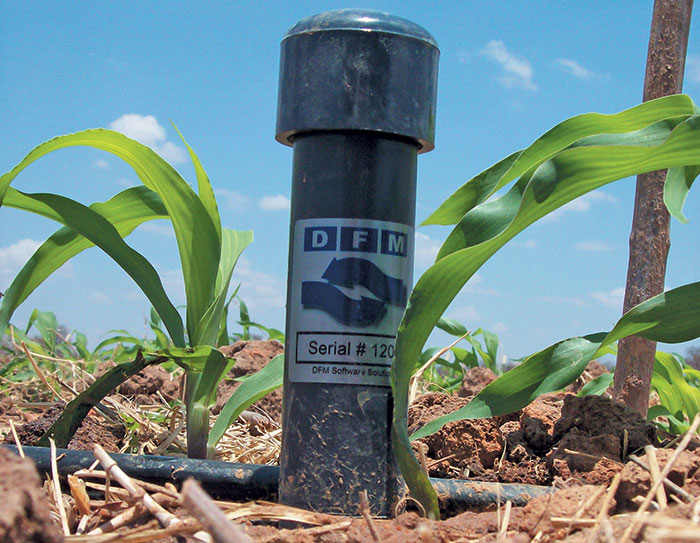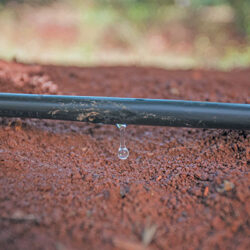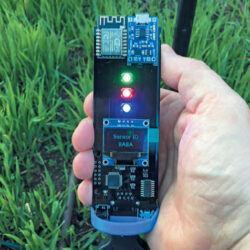To provide an optimal environment for crop growth, a farmer must irrigate correctly. This will ensure that soil moisture levels are neither too high nor too low.
So says Dirk Mercker, CEO of DFM Technologies, which manufactures continuous logging soil moisture probes.
“You have to use water more efficiently to increase productivity from each drop of water. If you use water correctly, you can get up to 50% water savings, and increase yield at the same time,” says Dirk.
But before irrigating optimally, a farmer needs to understand the plant’s root system, its interaction with the soil environment, and how roots benefit from optimal soil moisture and oxygen.
It’s also necessary to know how water is used by plants to stimulate root and plant growth.
“In essence, roots need more oxygen than water to grow and farmers don’t actually manage water, but rather the oxygen movement in soil,” says Dirk.
Root respiration is an intricate part of plant growth, where the roots take up oxygen from the soil. The oxygen reacts with the carbohydrates produced in the leaves through photosynthesis to generate the energy needed for root development. Carbon dioxide, a by-product, is released back into the soil.
“During this process, the soil’s air-water balance is critical to promote root development for a healthier root system for more effective fertiliser uptake,” says Dirk.
Calcium Uptake
In the root’s growing area, the cells formed just behind the tip lengthen rapidly and push the tip further into the soil with considerable force. The force comes from water pressure generated by osmosis. This part of the root is responsible for most of the plant’s calcium uptake.
Most of the nutrients, and especially calcium, are absorbed by the young roots, as their cell structure is still highly elastic and can allow the large calcium molecules to enter. Other nutrients attach themselves to the calcium and enter the same way.
Within one or two days, the epidermis cells harden and calcium molecules can no longer enter the root cells. Continuous root growth, and thus continuous oxygen supply, is therefore required for optimal fertiliser uptake, says Dirk.
The root hair region follows the growing region. This is a thick, white down consisting of thousands of tiny hairs that are single-cell outgrowths of the epidermis.
They increase root area and use osmosis to absorb water with dissolved mineral salts from the soil. Each root lives for a maximum of two days, and together, they are responsible for more than 95% of the plant’s water uptake.
If a plant is under stress for more than a day or two, the root hairs die off and the plant‘s water uptake potential is reduced by more than 95%. It takes another two days for new root hairs to develop, explains Dirk.
Irrigation zone
South Africa is water scarce, and management of this commodity is therefore critical and will become more so as climatic conditions continue to change, Dirk says.
In addition, correct water use directly affects profitability and is therefore crucial for local farmers already struggling with increasing input costs.
“We have to produce more, but with less water,” he stresses.
Correct scheduling is needed to achieve maximum yield from crops with the least amount of water.
The best practice, according to Dirk, is to split the soil profile into separate management zones, namely the O-, A- and B-horizons, and implement dual-cycle irrigation principles.
Many plants have two root systems. In the nutrient-rich upper layer of the A-horizon, they have fine feeder roots. If this upper layer is adequately moist, the plant can extract all the food and water it needs.
If the upper layer dries out, the plant will use its survival roots in the B-horizon to extract moisture. “Many nutrients such as phosphorus and calcium are not mobile and are absent in this deep layer. The plant will survive, but not flourish,” Dirk explains.
During a heatwave, however, a plant tends to extract more water from this deep layer.
With probes, a farmer can check that the different zones are sufficiently moist, reducing the risk of water stress or saturation at any level.
“You can monitor the depletion rate of plants, and see at what water content level the plant is achieving maximum transpiration rates,” says Dirk.
“This is the point of optimal soil air-water balance to achieve optimal water and nutrient uptake potential, thus optimising yield and quality. It’s normally the waterlogged conditions that generate the permanent damage during plant stress.”
With probes, a farmer can also monitor how much water was extracted from a specific zone and check if there was enough root growth in a season by the amount of extraction recorded.
In addition, the farmer can also apply controlled stress conditions using the probes.
“By drying down part of the root system, the roots produce ethylene, which signals stress conditions to the rest of the plant,” says Dirk. “The plant will change its focus from productive growth to fruit production. This increases yield and quality.”
The right software
The success of soil water probes lies in the way the data is processed. The data must be easily interpretable and should represent the rain-equivalent millimetres of water content to simplify any calculation and make it soil-type independent.
As probes are so expensive, Dirk’s advice is to start with only a few.
“You can also use one per different type of cultivar or soil type, and use that as a reference for the remaining irrigation blocks or centre pivots,” he adds.
Software for irrigation management should show what the probes are registering and give the farmer the option of selecting a management style for specific lands or irrigation blocks. The system should then assist the farmer to work out how water should be used in that block.
Water, soil and oxygen are tied together and each affects the other, says Dirk.




